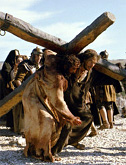
Movie Guru Rating:

Comment
on this review
| |

The Passion is the gospel according to Mel
by Lee Gardner
Jesus is thrown over the side of a stone bridge and plummets toward the ground, only to be brought up inches short of impact with a sickening lurch as he reaches the ends of his chains. Jewish soldiers and members of angry mobs hit him again and again and again and again and again and again, until his right eye swells shut like a blood-filled plum. Cackling Roman soldiers scourge his flesh with rods and jagged flails until his flesh is hamburger and a few yellow staves of ribcage show through his side, until the courtyard around the post looks like the pavement around a gruesome highway pile-up. The soldiers press a crown of thorns into his brow, and he is forced to drag a cumbersome wooden cross through the streets of Jerusalem, streaming blood, whipped and kicked and beaten at every step. He collapses to the ground in agonizing slow motion again and again and again and again and again, his one open eye a blank, his mouth a gory hole.
And then, then, the Romans set about crucifying him. By the time director Mel Gibson’s The Passion of the Christ unspools to that fatal point, near the two-hour mark, the audience has a right to wonder who is being tortured here.
Gibson’s self-financed labor of love generated controversy months before its release, as early reports stirred worries that the film revived troublesome old prejudices and accusations that the Jews were responsible for Christ’s death.
Well it does. But any flap over its many inexplicably hateful and conniving Jewish characters is likely to be subsumed by the realization that Gibson, by all accounts a deeply devout man, has created a holy slasher movie in which James Caviezel’s looooong-suffering Jesus is the victim each and every time. Even as an obviously obsessive personal vision of Christ’s sacrifice, it is far too much. As a stand-alone film, it is far too little, and poorly handled at that.
Opening on Jesus’ fevered prayers in the garden of Gethsemane, The Passion follows the last 24 hours of his earthly life as he is arrested and summarily tried by the Jewish high priesthood, who take their captive to the Roman occupiers of Judea and demand his execution; after much buck-passing, the priests get their wish. It is a well-known story, of course, but Gibson (who co-wrote the script with Benedict Fitzgerald) relies too much on that familiarity. It is never adequately explained why the priests and the mobs hate him so. A few flashbacks of Jesus’ life and teachings offer glimpses of the savior as a human being and bolster Gibson’s themes of sacrifice and redemption, but they hardly get the audience acquainted with the character. It is as if the director expects you to spot Caviezel in his wig and beard and instantly care what happens to him.
For all the faith Gibson shows with that gambit, he displays shockingly little respect for his audience otherwise. Not content to show Jesus wrestling with the invisible torments of temptation and foreknowledge of his fate, the director introduces a hairless, androgynous Satan (Rosalinda Celentano) to stalk around looking weird and ominous. The treacherous Judas (Luca Lionello) can’t be hounded to his death by his guilty conscience; a pack of demon children/dwarves have to do it. Gibson apparently never met an over-obvious soundtrack cue or portentous slo-mo shot he didn’t like. (One suspects the film could’ve been a half-hour shorter if he’d shot the whole thing at 24 frames per second.) As the crucifixion culminates, he chucks his carefully cultivated period realism for a series of over-the-top out-of-nowhere CGI shots. In short, The Passion is the kind of movie where the instant the unbelieving thief crucified alongside Jesus mocks the Son of God, God/Gibson dispatches a crow to pluck out his right eyeball. Subtle it ain’t.
Which is a shame, because the film features many affecting moments—ironically, almost none of them centering on Jesus. Gibson imbues the sufferings of Jesus’ mother, Mary (Maia Morgenstern), with quiet power. Resigned as she is in some ways to her son’s fate, she must watch her little boy, her flesh, agonizingly destroyed before her eyes; from a flashback to a childhood fall to a final kiss that leaves her lipsticked with Jesus’ blood, Gibson and Morgenstern work a few small miracles together.
But in the end, the potential onscreen power of Jesus’ sacrifice is undercut by the grotesque overstatement of its depiction. When skin rips and crimson spatter flies, Gibson dollies in so we don’t miss a drop. The flinch reflex goes numb, and the film starts to seem as much a trudge as Christ’s long walk to his doom—it’s hard to keep identifying with a character when you would have dropped dead from shock alone hours before.
In the Biblical story of Jesus, all of his suffering amounts to something larger than itself, than himself—the redemption of the human soul. In The Passion of the Christ, matters of the soul are obscured by a morbid obsession with flesh and blood. Mostly blood.

February 26, 2003 * Vol. 14, No. 9
© 2000 Metro Pulse
|





